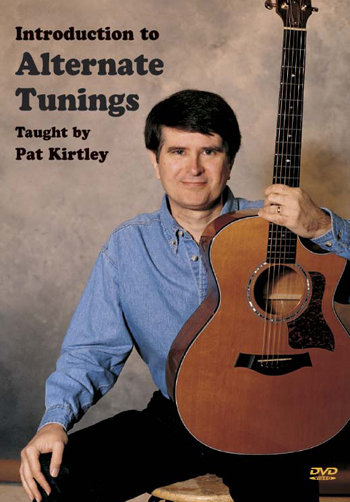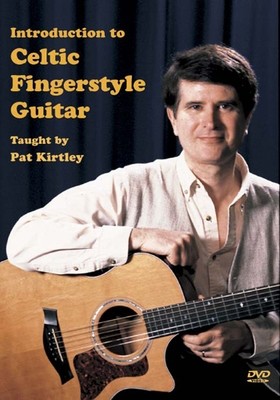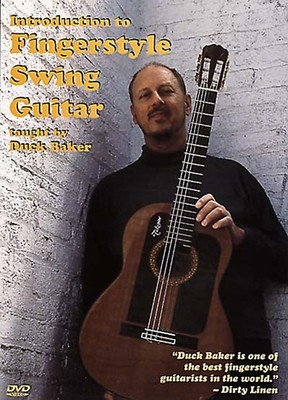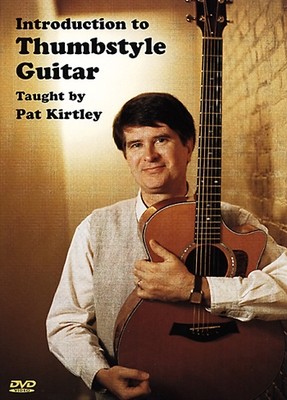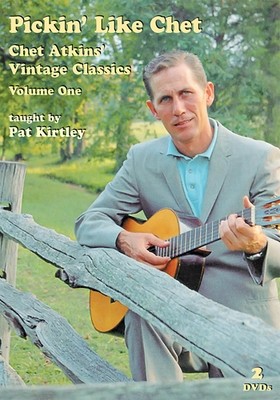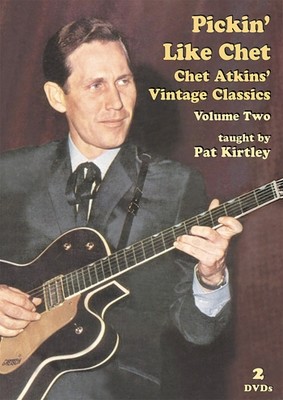
Introduction to Alternate Tunings - taught by Pat Kirtley
This DVD provides the answer for guitarists who want to begin to explore the world of alternate tunings. In this lesson Pat Kirtley presents simplified but highly musical and playable arrangements in four different tunings. The arrangements presented were chosen for advanced-beginner to intermediate skill level, and to illustrate the differences and unique features of each tuning. This is an excellent first step into an interesting aspect of contemporary guitar playing.
Pat shows you:
- How to tune your guitar to each of the tunings
- How to get into the tunings without need for an electronic tuner
- The pros and cons of alternate tunings
- Complete instruction for each tune including full explanations and split-screen versions showing both hands at once
- Harmonic "chime" techniques
- Right-hand fingerstyle techniques
Titles include: Battle Hymn of the Republic (Drop D tuning: DGDGBE), Spanish Fandango (Open G tuning: DGDGBD), Both Sides Now (Open G tuning: DGDGBD), Amazing Grace (DADGAD) and Steel Guitar Rag (EADEAE)
93 minutes - Level 2/3 - Detailed tab/music PDF file on the DVD
Review: Imagine that you're an acoustic guitarist who has been playing for a few years and you'd like to become a proficient fingerpicker. You want to learn some open tunings, you'd like to play a few nice Celtic tunes, and most of all you want to get your thumb to play alternating bass notes and do that cool boomchuck thing. If this scenario describes your situation, I highly recommend Pat Kirtley's three new videos from Stefan Grossman's Guitar Workshop.
Kirtley is a knowledgeable and accomplished picker who in recent years has won major guitar competitions and put out several fine CDs. He's a good arranger and an even better writer, yet all that might not mean a thing to guitar students if he wasn't also a good teacher. As Kirtley's three video lessons show, lie's personable and articulate, and his method is deliberate and patient. He also teaches some really nice tunes.
A good place to start is with Kirtley's Introduction to Thumbstyle Guitar. Being from Kentucky, the birthplace of boom chuck, Kirtley has a particular affinity for thumbstyle, yet he's not a dyed-in-the wool Merle Travis devotee. In fact, Kirtley encourages students throughout each of his lessons to play the way they feel these tunes should be played. "If you play what you feel, you'll be playing better music," he says. Still, Kirtley offers plenty of specific instruction and advice. He covers how to use a thumbpick and get a good sound with it. He also recommends developing a smooth, rhythmic feel with your thumb before working in the melody notes instead of trying to make it all happen at once. Kirtley's interpretations of thumbpicking standards such as "I Am a Pilgrim," "I'll See You in My Dreams", "Deep River Blues", and "Guitar Rag" capture the essence of the tunes without mimicking the players who made them famous.
In Introduction to Alternate Tunings, Kirtley covers the most popular variants-dropped D, open G, and D A D G A D-with tunes such as "Battle Hymn of the Republic", "Spanish Fandango", "Both Sides Now", and "Amazing Grace", along with his arrangement of "Steel Guitar Rag" in E A D E A E. Students will find it particularly helpful that Kirtley demonstrates how to get to the desired open tuning from standard tuning, rather than just showing you what the tuning is. Although electronic tuners do the job, he recommends using your ear to retune by matching octaves with other strings that are already at the correct pitch. He also recommends checking all the notes after changing tunings, since the change in tension can sometimes detune strings that weren't altered.
Kirtley uses D A D G A D exclusively on Introduction to Celtic Fingerstyle Guitar Although students should have little difficulty with his arrangement of the Scottish "Skye Boat Song", the rest of the fine material in this lesson is fairly challenging. Many important aspects of the style are covered, such as the proper ornamentation of melody lines. "We guitarists have sort of insinuated ourselves into Celtic music", says Kirtley. "What we're doing is imitating the sounds of instruments like fiddle and pipes." Kirtley also discusses how to play the rhythmic forms of jigs, reels, and airs on the guitar, and his playing of "The Blarney Pilgrim" and the beautiful air "South Wind" is sure to inspire even the most skeptical student to more fully explore this wonderful and complex music on the guitar. Isn't that what teaching is all about? – Acoustic Guitar
